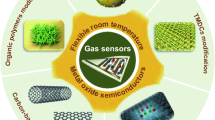Abstract
Electronic Nose, as an artificial olfaction system, has potential applications in environmental monitoring because of its proven ability to recognize and discriminate between a variety of different gases and odors. In this paper, we used a chemical sensor array to develop an electronic nose to detect and identify seven different gases (H2, C2H2, CH4, CH3OCH3, CO, NO2, and NH3). These gas sensors are chosen because of its hierarchical/doped nanostructure characteristics, which give them a very high sensitivity and low response time; we improve the linearity response and temperature dependence using models based on artificial neural networks. We used in Electronic nose a pattern recognition based on artificial neural network, which discriminates qualitatively and quantitatively seven gases and has a fast response.













Similar content being viewed by others
References
Hwang, S., Kwon, H., Chhajed, S., Byon, J. W., Baik, J. M., Im, J., et al. (2013). A near single crystalline TiO2 nanohelix array: enhanced gas sensing performance and its application as a monolithically integrated electronic nose. Analyst, 138, 443. https://doi.org/10.1039/c2an35932d.
Fan, G. K., Wang, Y., Hu, M., Lou, Z. Y., & Li, G. (2011). Synthesis of flower-like nano-SnO2 and a study of its gas sensing response. Measurement Science & Technology, 22, 045203–45204. https://doi.org/10.1088/0957-0233/22/4/045203.
Khaldi, S., & Dibi, Z. (2016). ANN modeling of electronic nose based on co-doped SnO2 nanofiber sensor. Sensors & Transducers, 200(5), 24–28.
Akhtar, K., Haq, I. U., & Malook, K. (2015). Gas sensing properties of semiconducting copper oxide nanospheroids. Powder Technology, 283, 505–511. https://doi.org/10.1016/j.powtec.2015.06.023.
Su, J., Li, Z., Zhang, Y., Wei, Y., & Wang, X. (2016). N-doped and Cu-doped TiO2-B nanowires with enhanced photoelectrochemical activity. RSC Advances, 6, 16177.
Rani, R., & Sharma, S. (2016). Preparation and characterization of SnO2 nanofibers via electrospinning. Advances in Nanoparticles, 5, 53–59. https://doi.org/10.4236/anp.2016.51006.
Yin, X., Zhang, L., Tian, F., & Zhang, D. (2016). Temperature modulated gas sensing e-nose system for low-cost and fast detection. IEEE Sensors Journal, 16(2), 464–474. https://doi.org/10.1109/jsen.2015.2483901.
Khudair, B. H., Jasim, M. M., & Alsaqqar, A. S. (2018). Artificial neural network model for the prediction of groundwater quality. Civil Engineering Journal, 4(12), 2959–2970. https://doi.org/10.28991/cej-03091212.
Bahrekazemi, S., & Hekmatzadeh, M. (2017). Neuro-simulation tool for enhanced oil recovery screening and reservoir performance prediction. Italian Journal of Science & Engineering, 2, 54–64. https://doi.org/10.28991/ijse-01111.
Zamanisabzi, H., King, J. P., Dilekli, N., Shoghli, B., & Abudu, S. (2018). Developing an ANN based streamflow forecast model utilizing data-mining techniques to improve reservoir streamflow prediction accuracy: A case study. Civil Engineering Journal, 4(5), 1135–1156. https://doi.org/10.28991/cej-0309163.
Lee, J.-H. (2009). Gas sensors using hierarchical and hollow oxide nanostructures: Overview. Sensors and Actuators B, 140, 319–336. https://doi.org/10.1016/j.snb.2009.04.026.
Khaldi, S., & Dibi, Z. (2017). Neural network modeling of smart nanostructure sensor for electronic nose application. In Proceedings of the 6th international conference on systems and control (ICSC), University of Batna 2, Batna, Algeria, May 7–9, 2017. https://doi.org/10.1109/icosc.2017.7958690.
Huang, J., & Wan, Q. (2009). Gas sensors based on semiconducting metal oxide one-dimensional nanostructures. Sensors, 9, 9903–9924. https://doi.org/10.3390/s91209903.
Liu, L., Guo, C., Li, S., Wang, L., Dong, Q., & Li, W. (2010). Improved H2 sensing properties of Co-doped SnO2 nanofibers. Sensors and Actuators B, 150, 806–810. https://doi.org/10.1016/j.snb.2010.07.022.
Liu, L., Li, S., Zhuang, J., Wang, L., Zhang, J., Li, H., et al. (2011). Improved selective acetone sensing properties of Co-doped ZnO nanofibers by electrospinning. Sensors and Actuators B, 155, 782–788. https://doi.org/10.1016/j.snb.2011.01.047.
Wang, X., Zhao, M., Liu, F., Jia, J., Li, X., & Cao, L. (2013). C2H2 gas sensor based on Ni-doped ZnO electrospun nanofibers. Ceramics International, 39, 2883–2887. https://doi.org/10.1016/j.ceramint.2012.09.062.
Prasad, A. K., Amirthapandian, S., Dharaa, S., Dasha, S., Muralib, N., & Tyagi, A. K. (2014). Novel single phase vanadium dioxide nanostructured films for methane sensing near room temperature. Sensors and Actuators B, 191, 252–256. https://doi.org/10.1016/j.snb.2013.09.102.
Li, C., Lv, M., Zuo, J., & Huang, X. (2015). SnO2 highly sensitive CO gas sensor based on quasi-molecular imprinting mechanism design. Sensors, 15, 3789–3800. https://doi.org/10.3390/s150203789.
Gao, L., Cheng, Z., Xiang, Q., Zhang, Y., & Xu, J. (2015). Porous corundum-type In2O3 nanosheets: Synthesis and NO2 sensing properties. Sensors and Actuators B, 208, 436–443. https://doi.org/10.1016/j.snb.2014.11.053.
Yamazoe, N., Fuchigami, J., Kishikawa, M., & Seiyama, T. (1979). Interactions of tin oxide surface with O2, H2O and H2. Surface Science, 86, 335–344. https://doi.org/10.1016/0039-6028(79)90411-4.
Author information
Authors and Affiliations
Corresponding author
Additional information
Publisher's Note
Springer Nature remains neutral with regard to jurisdictional claims in published maps and institutional affiliations.
Rights and permissions
About this article
Cite this article
Khaldi, S., Dibi, Z. Neural Network Technique for Electronic Nose Based on High Sensitivity Sensors Array. Sens Imaging 20, 15 (2019). https://doi.org/10.1007/s11220-019-0233-3
Received:
Revised:
Published:
DOI: https://doi.org/10.1007/s11220-019-0233-3




